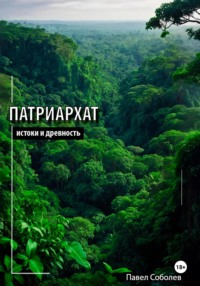Читать книгу: «Патриархат: истоки и древность», страница 20
196. Pettazzoni, R. (1956). The All-Knowing God: Researches into Early Religion and Culture.
197. Powers S. (1877) Tribes of California, Contributions to North American Ethnology, Vol. III.
198. Power C. Hadza gender rituals – epeme and maitoko – considered as counterparts // Hunter Gatherer Research. 2015. Vol. 1 (3). P. 333-358.
199. Power, C., Watts, I. The Woman With The Zebra's Penis Gender, Mutability And Performance // Journal of the Royal Anthropological Institute, 1997, Vol. 3 Issue 3, p 537-560.
200. Radcliffe-Brown, A.R. (1964) – The Andaman Islanders, Free Press.
201. Read, K.E. (1954). Cultures of the Central Highlands. Southwestern Journal of Anthropology 10:1-43.
202. Reigle, R. (2015). Mono- versus poly-genesis of music cosmologies in Amazonia and New Guinea.
203. Reznikoff, I. (2010). La dimension sonore des grottes paleolithiques et des rochers a peintures.
204. Russell, N., 2012. Social Zooarchaeology: Humans and animals in prehistory. New York (NY): Cambridge University Press.
205. Sassaman, K. (2004). Complex Hunter-Gatherers in Evolution and History: A North American Perspective – Journal of Archaeological Research, Vol. 12, No. 3, p. 227-280.
206. Schapera, I. 1930. The Khoisan Peoples of South Africa: Bushmen and Hottentots. London: George Routledge and sons.
207. Schebesta, P. (1936). Revisiting my pygmy hosts. London.
208. Schnirelman, V. (1992). Complex hunter-gatherers: Exception or common phenomenon? – Dialectical Anthropology, 17:183-196.
209. Sear, R., Mace, R. (2008). Who keeps children alive. A review of the effects of kin on child survival, Evolution and Human Behavior 29 (2008) 1-18.
210. Seitz, S. (1977). Die zentralafrikanischen Wildbeuterkulturen. In – Studien zur Kulturkunde, 45.
211. Selvakumar, V. 2002. Hunter-Gatherer Adaptations in Madurai Region, Tamil Nadu, India: From c. 10,000 B.P. to c. A.D. 500. Asian Perspectives 41 (1): 71-102.
212. Shimelmitz, R. et al. (2023). Large Predator Hunting and Its Interpretation: Leopards, Bears and Lions in the Archaeological Record of the Southern Levant // Cambridge Archaeological Journal, 33, Issue 1, pp. 137-156.
213. Silberbauer, G.B. The Gwi Bushmen // Hunters and gatherers today – New York, 1972, 271-326.
214. Sivak E., Smirnov I. Parents mention sons more often than daughters on social media // Proceedings of the National Academy of Sciences of the United States of America. 2019. Vol. 116. No. 6. P. 2039-2041.
215. Skaanes, Th. (2017). Sounds in the night: Ritual bells, therianthropes, and eland relations among the hadza – In: Human origins: contributions from social anthropology, pp.204-223.
216. Slotten, R. (1965). The Master of Animals – a Study in the Symbolism of Ultimacy in Primitive Religion – Journal of the American Academy of Religion, Volume XXXIII, Issue 4, 1965, pp. 293–302.
217. Solomon, A. (1992). Gender, representation and power in San ethnography and rock art. Journal of Anthropological Archaeology, 11: 291-329.
218. Speth, J.D. The Paleoanthropology and Archaeology of Big-Game Hunting: Protein, Fat, or Politics? – New York, 2010.
219. Stockard, J. E. Marriage in culture: practice and meaning across diverse societies – Roundhouse, 2002.
220. Surbeck, M., Cheng, L., Kreyer, M. et al. Drivers of female power in bonobos // Communications Biology 8, 550 (2025).
221. Tabet, P. (1979). Les mains, les outils, les armes.– L'Homme, 19:3-4, pp. 5-61.
222. Talbot, A.D. (1915) Woman's Mysteries of a Primitive People: The Ibibios of Southern Nigeria.
223. Terashima, H. (1987). Why Efe Girls Marry Farmers? Socio-Ecological Backgrounds of Inter-Ethnic Marriage in the Ituri Forest of Central Africa – African Study Monographs: Supplementary Issue. #6. p. 65-83.
224. Tsuru D. (1998) Diversity of ritual spirit performances among the Baka pygmies // African Study Monographs, Suppl. 25: 47 – 84, March 1998.
225. Turnbull, C. (1961). The Forest People – NY, Simon and Schuster.
226. Turnbull, С. (1965). The Mbuti Pygmies: an ethnographic survey. Anthropological Papers of the American Museum of Natural History, 50(3): 137-282.
227. Venkataraman W. (2023). Debunking a debunking: A Critique Of Anderson et al.’s (2023) Plos One Paper On Women’s Hunting.
228. Walker, P., Hewlett, B.S. (1990). Dental health diet and social status among Central African foragers and farmers. Am. Anthrop. 92, 383-98.
229. Walker, R.S., Hill, K.R., Flinn, M.V., Ellsworth, R.M. (2011). Evolutionary History of Hunter-Gatherer Marriage Practices. PLoS ONE 6(4):e19066.
230. Webster H. Primitive Secret Societies – New-York, 1908.
231. Wiessner, P. 1996. Leveling the Hunter: Constraints on Status Quest in Foraging Societies, in: Food and the status quest: an interdisciplinary perspective – Berghahn Books, pp. 171-193.
232. Witzel, M. (2012). The Origins of the World's Mythologies – New-York: Oxford University Press.
233. Wood, B.M., Marlowe, F.W. Toward a Reality-Based Understanding of Hadza Men’s Work: A Response to Hawkes et al. (2014) // Hum Nat (2014) 25:620-630
234. Woodburn, J. (1964). The social organization of the Hadza of North Tanganyika. – Ph.D. Dissertation, Cambridge University, Cambridge.
235. Woodburn, J. (1968). An introduction to Hadza ecology // Man the Hunter, pp. 49-54.
236. Woodburn, J. (1979). Minimal politics: The political organization of the Hadza of North Tanzania. In: Politics and leadership: A comparative perspective (pp. 244-266).
237. Woodburn, J. (1982a). Egalitarian Societies. Man. New Series, 17(3), 431–451.
238. Woodburn, J. (1982b). Social dimensions of death in four African hunting and gathering societies. In: Bloch, Maurice; Parry, Jonathan. Death and the regeneration of life, pp. 187–210.
239. Woodburn, J. (2005). Egalitarian Societies Revisited – In: Property and equality, volume 1: ritualisation, sharing, egalitarianism / edited by Thomas Widlok and Wolde Gossa Tadesse, p. 18-31.
240. Yeshurun, R., Bar-Oz, G., Weinstein-Evron, M. Modern hunting behavior in the early Middle Paleolithic: Faunal remains from Misliya Cave, Mount Carmel, Israel // Journal of Human Evolution 53 (2007) 656-677.
241. Zerries, O. (1953). The bullroarer among South American Indians. Revista do Museu Paulista 7. 275-310.
Покупайте книги и получайте бонусы в Литрес, Читай-городе и Буквоеде.
Участвовать в бонусной программе
